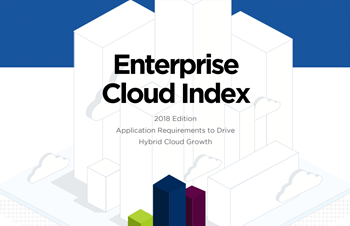The cloud should by now be an important part of any company's IT strategy. But its been around awhile, and it may therefore be getting to the stage where firms that were quick to embrace the technology in its earlier days may actually be getting left behind.
This is especially true if you haven't reviewed and evaluated your cloud strategy in some time. While one of the benefits of the cloud is that you can take advantage of upgrades and security patches that are managed and rolled out by your provider, this doesn't mean you can take a more hands-off approach than you would with a legacy on-premise system.
Cloud is an ongoing commitment and must be treated accordingly. This means you should still be reviewing your strategy frequently to identify any weaknesses or inefficiencies that can be addressed, and be aware of any new developments or trends that could affect your decision-making.
Strong cloud security requires strong leadership
Equip your team with the right tools to improve visibility, reduce risk & respond to threats faster.
VISIT THE HUB ifp.ClickDetails"In particular, multi-cloud solutions have come a long way in the past few years, and are now the default option for many firms. Indeed, figures from Gartner suggest more than four-fifths of businesses (81%) now use two or more cloud providers.
But are you sure your own use of multi-cloud is making the most of the technology? Here are a few key signs that your operations may be in need of an overhaul to bring them up to date.
Your current cloud strategy is vague or undefined
The first sign your cloud environment is overdue for a makeover is if you don't have a clear, coherent strategy for how you deploy your cloud services. If you can't immediately answer what services are on the cloud, what your plans are for migrating other services to this platform, and - most importantly - why you’re using the cloud, it's a sign you aren't giving the technology the attention it requires.
If you've turned to the cloud simply to jump on the bandwagon, you'll never make the most of it. Therefore, developing a clear strategy that outlines what benefits you expect to receive - and how you’ll measure these benefits - should be the first step in any overhaul. Having clear, measurable goals in mind will help focus your decisions and ensure they’re delivering a positive ROI.
You're not cloud-first
Simply having services in the cloud is no longer enough to qualify as having a good strategy. In today's world, it's not enough for the IT department to migrate existing services to the cloud when they believe it will offer cost savings or greater efficiency.
Instead, cloud should be the default option for any operation, both new and existing. This cloud-first approach ensures that any new applications and operations are designed from the ground up with the cloud in mind.
This is hardly a new idea, and is supported by even the largest organizations. The UK government, for instance, first initiated a cloud-first policy in 2013 for its own technology decision-making, citing greater flexibility, security and scalability as among its key benefits. Therefore, if you aren't considering the cloud first today, you'll find yourself at a significant disadvantage.
However, it's important to remember that cloud-first doesn't mean cloud-only. There's always going to be a place for on-premise solutions in many businesses, and if there are compelling reasons to keep certain applications and operations within your business, you shouldn't feel obliged to ignore these simply to pursue a cloud alternative. Knowing what will work better in the cloud and what should be retained on-premises is a hallmark of a confident cloud strategy.
You don't have a clear multi-cloud policy
Multi-cloud - a solution that involves businesses running several different cloud services from different providers - has become one of the most common ways of engaging with cloud solutions. There are numerous benefits to this, including avoiding vendor lock-in, ensuring compliance with various regulations, and to guarantee resilience by not having a single point of failure.
But not going into this with a clear policy can result in wasted time and effort, as well as uncertainty over what service you have.
For instance, it may be the case that while you have IT-approved cloud applications for key operations, which have been thoroughly vetted and approved for security and compatibility with existing systems, there could be many other cloud-based solutions being procured and managed directly by business units.
One survey, for instance, found that IT professionals in the US estimate the average number of cloud services in use within their organization to be 31. But in fact, the true figure is 1,935. These tools cover every aspect of a business and many will be based around consumer-focused products rather than solutions engineered specifically for enterprise use.
This isn't just exposing your cloud environment to a variety of security risks. It could also mean you have multiple cloud services effectively doing the same thing across different departments. This means added expenses, duplicated effort and the potential for delays if services aren't interoperable with each other.
You aren't embracing continuous evolution
A common issue with many business' first-generation efforts in the cloud is they’ve stuck too closely to their legacy on-premises architecture. In many cases, they may have migrated servers directly to the cloud without giving much, if any, thought to whether or not their existing approach is well-suited to cloud architectures.
This can mean that businesses are failing to make full use of the flexibility and agility benefits that cloud computing can offer. It will also mean that cloud deployments end up costing much more money than they have to.
Even the best-designed multi-cloud environments can quickly become complex projects, and it will take time for them to deliver their full benefits, so patience will always be a virtue when managing these systems. However, firms need to always be looking ahead to the next steps and continuously working to improve the maturity of their cloud systems.
This means both having a clear, ongoing plan in place to improve employee skill levels with the technology and constantly evaluating and identifying the latest and most appropriate cloud solutions. Focusing on the technology itself can often be overlooked if organizations are prioritizing staff education or ensuring that cloud systems are accepted by business units.
Constantly reviewing your environment is therefore the key to effective multi-cloud management. Key scenarios that can be used as opportunities to overhaul strategies may come when your organization opens up new business units or locations, or if you're involved in an acquisition. Other useful drivers of an update will include regulatory or compliance changes, or when significant new innovations offered by your cloud providers. In such cases, having a roadmap already worked out about where you go next will be immensely helpful.
Further reading:
- The Cloud Security Maturity Index: How Secure is Your Cloud?
- How to Manage Multiple Cloud Providers
- How to Lock Down the Cloud Control Plane with CSPM
- Unify Your Multi-Cloud: How to Create a Cohesive Security Strategy
Access the latest business knowledge in IT
Get Access






Comments
Join the conversation...